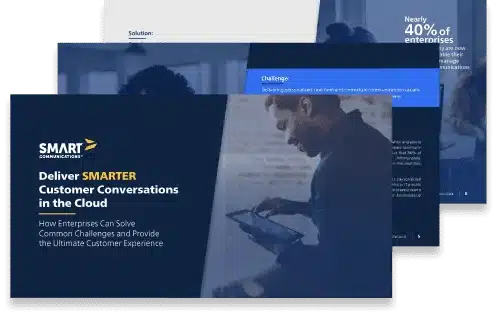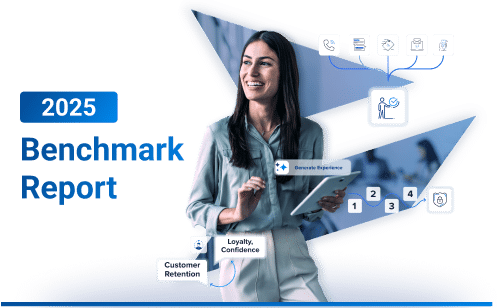Master Medicare Enrollment: 5 Steps to Efficient Healthcare Customer Communications

By John Zimmerer, VP of Healthcare Marketing at Smart Communications
The annual enrollment period (AEP) for Medicare Advantage, Prescription Drug, and 1876 Cost Plans is just as stressful for health payers as it is for enrollees. With each open enrollment season comes new requirements and regulations from the Centers for Medicare and Medicaid Services (CMS), including those governing what CMS considers “marketing communications”.
Chief among these healthcare customer communications are the Annual Notice of Change (ANOC) and the Evidence of Coverage (EOC), but there are many others, including the Summary of Benefits, provider and pharmacy directories, and drug formularies. While CMS has traditionally provided model materials for key communications, as payers know, the hard part is customizing these templates with the individual plan details contained within the plan benefit package (PBP) for each CMS-approved plan.
Even though the ANOC and EOC documents are prescribed by CMS, they can still impact Star Ratings. Accurate Annual ANOCs and EOCs are crucial in maintaining member confidence and avoiding costly errors and Errata sheets. Poor communication can negatively impact Consumer Assessment of Healthcare Providers and Systems (CAHPS) survey results, which are vital for Star Ratings. Lower Ratings can lead to loss of members and quality bonus payments.
In this article, I outline the steps to successfully manage enrollment communications like the ANOC and EOC from CMS, and how a solution like SmartCOMM™ can streamline and speed up the process.
Step 1: Translate the PBP File into Variable Data
The first step is to mine the plan benefit package and other sources (e.g., PegaSystems’ Pega Product Composer) for data. This can be achieved through direct integrations between those sources and SmartCOMM, by exporting JSON or Excel from the web-based CMS Health Plan Management System (HPMS) for use in creating a data model, or by using third-party tools like those from CODY and Messagepoint. Alternatively, you can build a tool using our SmartIQ™ solution like one of our customers has done.
Any one of these options is better than scanning through the benefits in HPMS and manually creating variables and a related data table, as many payers do today.
Step 2: Convert the CMS Model Documents into Templates
The next step is to make the CMS-provided model documents useful. These come from CMS as Microsoft Word documents, with variants for each type of plan (FFS, POS, etc.). The goal is to create a project in SmartCOMM for each of the document types and, where possible, use business logic and content variants to generate documents for the various plan types using our Editions functionality.
From experience, I would recommend reviewing the model Word documents carefully, paying close attention to the defined styles. Minimize the number of styles used and ensure they are consistently applied to headers, body copy, and footers. Then, you can either use our Migration Studio to import the models and automate the conversion to SmartCOMM templates and reusable content, or you can manually copy and paste content from Word into SmartCOMM.
Step 3: Translate the Directions in the Model Materials into Business Logic
The model documents contain what can be described as quasi-business logic. In plain English statements, CMS provides instructions for including or excluding content depending upon the plan benefit structure. This needs to be converted to actual business logic in SmartCOMM.
Fortunately, the SmartCOMM business logic editor is user-friendly and English-like, unlike programming in JavaScript or other languages. Once written, a business rule can be reused within the same template and across multiple projects.
Step 4: Generate ANOC(s) and EOC(s) for Your Plan(s)
This part is simple. SmartCOMM can be triggered to generate ANOCs and EOCs in a variety of ways. You can generate a large batch of documents (e.g., at the beginning of the AEP for all current members), trigger them on-demand through integrations with core systems (e.g., Pega, Salesforce, etc.), or even create them ad-hoc, such as when a member calls to report their document didn’t arrive in the mail.
Step 5: Reusing Templates in Subsequent Plan Years
Once you have a base template for the model documents, you can re-use these templates and a significant portion of the content for subsequent plan years. You’ll need to know what changed from your base template and identify those changes in SmartCOMM. Typically, our customers compare the new CMS model documents with the ones used to create the base templates in SmartCOMM. This allows them to easily identify changes in content and business logic. They then duplicate the prior plan year’s project(s) in SmartCOMM and make the necessary updates. This approach saves considerable time and effort compared to starting from scratch every year.
Conclusion
Sophisticated CCM software like SmartCOMM can help reduce the stress and effort associated with managing Medicare materials and enrollment communications. Our Professional Services and Support teams have decades of experience helping our customers quickly adopt new requirements and regulations for all manner of member communications.



